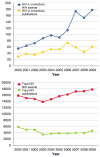HIV-related research in correctional populations: now is the time
- PMID: 21904902
- PMCID: PMC3208731
- DOI: 10.1007/s11904-011-0095-3
HIV-related research in correctional populations: now is the time
Abstract
The incarcerated population has increased to unprecedented levels following the 1970 US declaration of war on illicit drug use. A substantial proportion of people with or at risk for HIV infection, including those with substance use and mental health disorders, have become incarcerated. The overlapping epidemics of incarceration and HIV present a need for academic medical centers to collaborate with the criminal justice system to improve the health of incarcerated populations. With coordinated collaboration and new programmatic initiatives it is possible to reduce HIV-associated risk behaviors and the likelihood of acquisition and transmission of HIV. Centers for AIDS Research (CFAR), funded by the National Institutes of Health, have proactively responded to this need through Collaboration on HIV in Corrections (CHIC) to improve the diagnosis, treatment, linkage to care, and prevention of HIV. This collaboration serves as a model for aligning academic expertise with criminal justice to confront this challenge to individual and public health. This is especially relevant given recent evidence of the effectiveness of antiretroviral therapy in reducing HIV transmission.
Figures

References
-
- Pew Center on the States. One in 31: The Long Reach of American Corrections. Washington, DC: 2009.
Publication types
MeSH terms
Grants and funding
- R01 DA030762/DA/NIDA NIH HHS/United States
- K24 MH093243/MH/NIMH NIH HHS/United States
- R01AA018944/AA/NIAAA NIH HHS/United States
- P30AI028697/AI/NIAID NIH HHS/United States
- R01DA030768/DA/NIDA NIH HHS/United States
- R01 DA030778/DA/NIDA NIH HHS/United States
- R01 DA017059/DA/NIDA NIH HHS/United States
- P30 AI064518/AI/NIAID NIH HHS/United States
- P30AI036219/AI/NIAID NIH HHS/United States
- R21 DA029381/DA/NIDA NIH HHS/United States
- P30 AI027767/AI/NIAID NIH HHS/United States
- P30AI042853/AI/NIAID NIH HHS/United States
- P30 AI050409/AI/NIAID NIH HHS/United States
- P30 AI087714/AI/NIAID NIH HHS/United States
- K23DA029381/DA/NIDA NIH HHS/United States
- R01 DA029910/DA/NIDA NIH HHS/United States
- R01DA18641/DA/NIDA NIH HHS/United States
- P30AI073961/AI/NIAID NIH HHS/United States
- R01 DA025943/DA/NIDA NIH HHS/United States
- R01DA25932/DA/NIDA NIH HHS/United States
- R01 DA025932/DA/NIDA NIH HHS/United States
- P30 AI082151/AI/NIAID NIH HHS/United States
- P30AI064518/AI/NIAID NIH HHS/United States
- R01DA02721/DA/NIDA NIH HHS/United States
- P30AI078498/AI/NIAID NIH HHS/United States
- P30 AI054999/AI/NIAID NIH HHS/United States
- P30AI051519/AI/NIAID NIH HHS/United States
- P30AI036211/AI/NIAID NIH HHS/United States
- P30 AI051519/AI/NIAID NIH HHS/United States
- R01 AA018944/AA/NIAAA NIH HHS/United States
- K24 DA022112/DA/NIDA NIH HHS/United States
- P30AI082151/AI/NIAID NIH HHS/United States
- P30AI045008/AI/NIAID NIH HHS/United States
- P30 AI042845/AI/NIAID NIH HHS/United States
- P30AI060354/AI/NIAID NIH HHS/United States
- K23 DA020383/DA/NIDA NIH HHS/United States
- P30AI027763/AI/NIAID NIH HHS/United States
- P30AI050409/AI/NIAID NIH HHS/United States
- P30AI050410/AI/NIAID NIH HHS/United States
- P30AI042845/AI/NIAID NIH HHS/United States
- P30AI027757/AI/NIAID NIH HHS/United States
- P30AI036214/AI/NIAID NIH HHS/United States
- R01 DA018641/DA/NIDA NIH HHS/United States
- P30 AI045008/AI/NIAID NIH HHS/United States
- K01 AA020228/AA/NIAAA NIH HHS/United States
- UM1 AI069477/AI/NIAID NIH HHS/United States
- P30 AI028697/AI/NIAID NIH HHS/United States
- P30 AI073961/AI/NIAID NIH HHS/United States
- K24DA017072/DA/NIDA NIH HHS/United States
- K23 MH094250/MH/NIMH NIH HHS/United States
- P30 AI036211/AI/NIAID NIH HHS/United States
- R01 DA030768/DA/NIDA NIH HHS/United States
- P30AI027767/AI/NIAID NIH HHS/United States
- K23 DA021095/DA/NIDA NIH HHS/United States
- P30 AI027763/AI/NIAID NIH HHS/United States
- R01DA029910/DA/NIDA NIH HHS/United States
- R01 DA027211/DA/NIDA NIH HHS/United States
- K24 DA017072/DA/NIDA NIH HHS/United States
- P30 AI036214/AI/NIAID NIH HHS/United States
- R01DA025943/DA/NIDA NIH HHS/United States
- P30 AI027757/AI/NIAID NIH HHS/United States
- P30 AI078498/AI/NIAID NIH HHS/United States
- P30 AI042853/AI/NIAID NIH HHS/United States
- R01DA01705/DA/NIDA NIH HHS/United States
- R01DA030762/DA/NIDA NIH HHS/United States
- P30 AI060354/AI/NIAID NIH HHS/United States
- K23 DA019381/DA/NIDA NIH HHS/United States
- R01DA027211/DA/NIDA NIH HHS/United States
- P30AI054999/AI/NIAID NIH HHS/United States
- P30 AI027742/AI/NIAID NIH HHS/United States
- K24DA022112/DA/NIDA NIH HHS/United States
- P30 AI036219/AI/NIAID NIH HHS/United States
- P30AI027742/AI/NIAID NIH HHS/United States
- R01DA030778/DA/NIDA NIH HHS/United States
- P30 AI050410/AI/NIAID NIH HHS/United States
- K02 DA032322/DA/NIDA NIH HHS/United States
LinkOut - more resources
Full Text Sources
Medical

